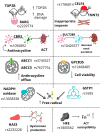Pediatric Chemotherapy Drugs Associated With Cardiotoxicity
- PMID: 34976454
- PMCID: PMC8679581
- DOI: 10.7759/cureus.19658
Pediatric Chemotherapy Drugs Associated With Cardiotoxicity
Abstract
Pediatric cancers are a common cause of childhood morbidity. As a result, chemotherapeutic regimens have been designed to target childhood cancers. These medications are necessary to treat pediatric cancers, however, oncology management options are accompanied by multiple negative and potentially fatal adverse effects. Although anthracyclines are the most commonly used chemotherapeutic agents associated with cardiotoxicity, we also explore other chemotherapeutic drugs used in children that can potentially affect the heart. Genetic variations resulting in single nucleotide polymorphism (SNP) have the propensity to modify the cardiotoxic effects of the chemotherapy drugs. The clinical presentation of the cardiac effects can vary from arrhythmias and heart failure to completely asymptomatic. A range of imaging studies and laboratory investigations can protect the heart from severe outcomes. The physiology of the heart and the effect of drugs in children vary vividly from adults; therefore, it is crucial to study the cardiotoxic effect of chemotherapy drugs in the pediatric population. This review highlights the potential contributing factors for cardiotoxicity in the pediatric population and discusses the identification and management options.
Keywords: anthracycline; cardiotoxic agents; chemotherapy associated cardiotoxicity; dexrazoxane; pediatric cancer.
Copyright © 2021, Hitawala et al.
Conflict of interest statement
The authors have declared that no competing interests exist.
Figures
References
-
- Estimating the total incidence of global childhood cancer: a simulation-based analysis. Ward ZJ, Yeh JM, Bhakta N, et al. Lancet Oncol. 2019;20:483–493. - PubMed
-
- Chemotherapy-induced cardiotoxicity in children. Bansal N, Amdani S, Lipshultz ER, Lipshultz SE. Expert Opin Drug Metab Toxicol. 2017;13:817–832. - PubMed
Publication types
LinkOut - more resources
Full Text Sources
Research Materials

